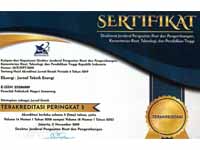Statistical Process Control And Analytical Hierarchy Process Methods For Reducing Earth Resistance
DOI:
https://doi.org/10.32497/eksergi.v19i2.4477Keywords:
Earth resistance, Statistical Process Control, Analytical Hierarchy ProcessAbstract
Security or protection systems at generators, substations, transmission, and housing and others, especially to overcome lightning disturbances and leakage currents, the earthing system must meet the required standards. For each part of the system, from transmission, substation and residential electricity utilization as well as other parts, the standard of earth resistance is not the same, for example for housing a maximum of 5 Ω, for a small generator system a maximum of 10 Ω, for a large generator a maximum of 20 Ω and so on etc. In areas where the soil type resistance is high, it is necessary to reduce the value of the earth resistance so that it reaches the Indonesian national standard. There are many ways to reduce the value of earth resistance, including lowering soil resistivity, adding electrodes to the soil, changing the type of electrode and its diameter, and so on. The aim of the research was to determine the effect of the value of earthing resistance on the depth of electrode planting and the type of soil that is affected by the water content in the soil and to apply simple statistical tools, namely Statistical Process Control (SPC) and Anlytical Hierarchy Process (AHP).
The measurement method in this research uses a three-point system, namely one point for the test electrode and two points for the auxiliary electrode and the measuring instrument used to measure earth resistance is a digital earth resistance tester type digital model 4105A. This tool is designed according to international electrical commission (IEC) standards. To analyze reducing earth resistance using Statistical Process Control (SPC) and Analytical Hierarchy Process (AHP) methods. The design of this research is to answer the problems and research objectives that have been planned, namely to determine the effect of soil type on earth resistance and to analyze efforts to reduce the value of earth resistance to achieve standards with statistical process control (SPC) and analytical hierarchy process (AHP) methods. To find potential causes, it is done by calculating the analytical hierarchy process (AHP) in order to obtain a sequence of problems to be solved. If the consistency ratio value is more than 10%, then the data judgment must be corrected, but if the consistency ratio is less than or equal to 10% then the calculation results are declared correct or accepted. From the results of the AHP calculation, it is then verified by testing the earth resistance.
References
Charisma, (2007). Pengaruh kedalaman penanaman dan jarak eletroda terhadap nilai tahanan pembumian, jurnal ilmu-ilmu Teknik-sistem, VOL. 5, (2) : (39-48)
Tadjudin, 1998. Analisis Perbandingan Kemampuan Elektroda Batang (Rod) dan Kombinasinya Dalam Mereduksi Nilai Tahanan Berdasarkan Struktur Tanah, (online), (http://elektroindonesia.com/elektro/ener14a.html, diaskes 21 Mei 2019)
Arman, (2000). Aplikasi Ahp Untuk Seleksi Tenaga Akaddemik, Jurnal Teknik Industri, Vol. 4, No. 4: (267 ”“ 274)
Andriyendi dan Rahmadi. (2011). Aplikasi AHP sebagai model SPK pemilihan dosen, proseding, ISSN 1907-5022, (1-6).
Arikunto, (2005). Prosedur Penelitian, Jakarta, Rineka Cipta.
Gaspersz, dkk (2001). Metode analisis untuk meningkatkan kualitas, Jakarta, Gramedia Pustaka Utama
Herman, dan Wahyudi, (2008). Metode parit melingkar untuk mereduksi resistensi pentanahan satu batang pentanahan, jurnal Media Teknik 1 (2), ISSN 0216-3012
Janardana. (2005). Perbedaan penambahan garang dengan penambahan bentonite terhadap nilai tanahan pentanahan pada sistem pentanahan, Vol 4, (1) : (24-28).
Janardana. (2005). Pengaruh unur pada beberapa volume zat aditif bentonite terhadap nilai tanahan pentanahan pada sistem pentanahan, Vol 4, (2) : (1-6).
Kencana, (2009) Analisis pengendalian mutu pada pengolahan minyak sawit dengan metode statistical quality control pada PTP Nusantara IV, Universitas Sumatera Utara.
Kadek Rudi Andika Setyawan, (2018), Analisis Sistem Pembumian Untuk Mengamankan Instalasi, Majalah Ilmiah Teknologi Elektro, Vol. 17, No. 2, diProgram Studi Teknik Elektro Fakultas Teknik Universitas Udayana Jimbaran Bali
Ishikawa, (1989) Teknik Penuntun Pengendalian Mutu, Jakarta, PT Mediatama Sarana.
[Subiyanto, Dkk. (2004). Engaruh porositas terhadap pentanahan dalam system tenaga listrik, Teknosains, Vol. 17, No. 2: (196-206)
Ingle, (1993) Pedoman Pelaksanaan Gugur Kendali Mutu, Jakarta, Pustaka Sinar Harapan.
Thamrin S., Sedrianus L., (2019) Studi Pembumian Peralatan Dan Sistem Instalasi Listrik Pada Gedung Kantor Bictpt. Pelindo I (Persero) Belawan, Jurnal Teknologi Energi Uda, Jurnal Teknik Elektro Volume VIII, Nomor 2 :96-101
Wahyono, Hamim,S. (2021) Analisis Upaya Menurunkan Tahanan Pembumian dengan Metode Spc, Prosiding NCIET Vol.2 (2021) B121 - B130
Wahyono (2012) Analisis Menurunkan Tahanan Pembumian yang Sesuai Standar dengan Metode Statistical Process Control dan Analytical Hierarchy Process. Magister thesis, Universitas Brawijaya.
Downloads
Published
Issue
Section
License
Authors who publish with this journal agree to the following terms:Authors retain copyright and grant the journal right of first publication with the work simultaneously licensed under a Creative Commons Attribution License that allows others to share the work with an acknowledgement of the work's authorship and initial publication in this journal.
Authors are able to enter into separate, additional contractual arrangements for the non-exclusive distribution of the journal's published version of the work (e.g., post it to an institutional repository or publish it in a book), with an acknowledgement of its initial publication in this journal.
Authors are permitted and encouraged to post their work online (e.g., in institutional repositories or on their website) prior to and during the submission process, as it can lead to productive exchanges, as well as earlier and greater citation of published work (See The Effect of Open Access).






